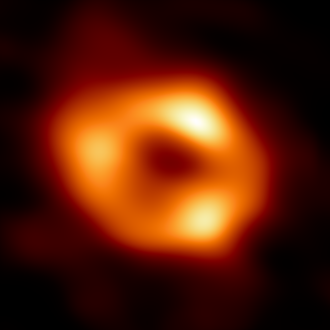
The scientists from the Event Horizon Telescope (EHT) collaboration published the first image of the supermassive black hole in the center of our galaxy, Sagittarius A*. The published image shows a characteristic ring, with a dark center related to the black hole’s event horizon. The measured diameter of this ring, around 52 microseconds of arc, agrees with the predictions of the Einstein’s General Relativity for a black hole of 4 million Suns mass, located at a distance of 27 thousands light years away. We do know the mass and distance rather well, thanks to the observations of the dynamics of stars in the Galactic Center, for which Andrea Ghez and Reinhard Genzel won a Nobel Prize in physics in 2020.
The EHT project is formed by about 300 scientists from over 100 institutes located in over 20 different countries. EHT is a global array of radiotelescopes capable of observing at high frequency of 230 GHz. Using the method of very-long-baseline interferometry, the telescopes form a single virtual radio dish of a diameter of Earth. In 2017 EHT observed the Galactic Center for the first time with an imaging-capable array configuration. Following 5 years of data calibration, analysis and interpretation, we learned about the results of these observations from a series of 10 papers published by the Astrophysical Journal Letters.
The key aspect of the Sagittarius A* data analysis was to characterize the source variability – the orbital timescale in the vicinity of a 4 mln solar masses black hole is about 30 minutes, while the aperture synthesis process necessary to perform imaging takes a couple of hours. What it means is that the final result is in a sense an average image of Sagittarius A*. The pioneering observations of the EHT suggest a low inclination of the source, a positive spin, and a large temperature difference between the protons and electrons.
Two Polish scientists, connected to NCAC, contributed to the EHT results, prof. Monika Moscibrodzka from Radboud University in Nijmegen (Holland) and dr. Maciek Wielgus, working at the Max Planck Institute for Radio Astronomy in Bonn (Germany) (both got their PhDs from Copernicus Center in Warsaw).
Picture:
Text: Maciej Wielgus






